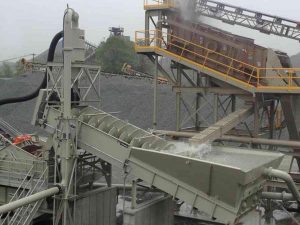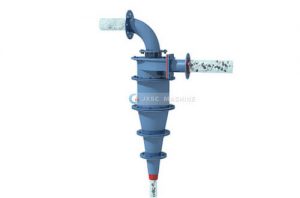Grinding and classification process
Ball mill and rod mill process
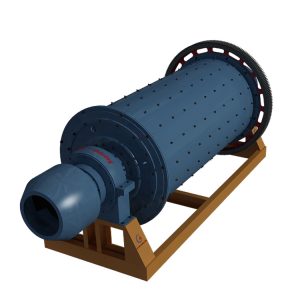
For beneficiation, one or two-stage grinding can economically grind the ore to any particle size required for beneficiation. The grinding of more than two stages is usually determined by the requirements of the selection of the stages.
Compared with the two-stage process, the main advantages of the one-stage grinding process are: less equipment, low investment, simple operation, and will not affect the work of the other grinding section due to the shutdown of one grinding section, and the shutdown loss is less.
However, the mill has a wide range of ore feeding size, it is difficult to load the balls reasonably, it is not easy to obtain a finer final product, and the grinding efficiency is low. When the maximum particle size of the final product is required to be 0.2~0.15mm (that is, 60%~79%-200 mesh), a one-stage grinding process is generally used. In a small factory, in order to simplify the process and equipment configuration, when the grinding fineness is required to be 80%-200 mesh, a one-stage grinding process can also be used.
The outstanding advantage of two-stage grinding is that finer products can be obtained, and coarse and fine grinding can be carried out in different grinding stages, which is especially suitable for stage processing. In large and medium-sized factories, when the grinding fineness is required to be less than 0.15mm (ie 80%-200 mesh), it is more economical to use two-stage grinding, and the product particle size composition is uniform, and there is less over-crushing. According to the connection between the first stage mill and the classifier, the two stages of grinding process can be divided into three types: the first stage is open; the second stage is fully closed; the first stage is partially closed, and the second stage always works in a closed circuit.
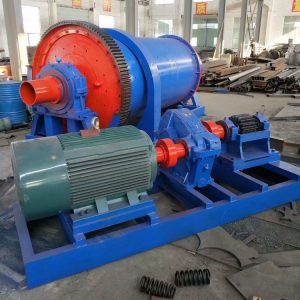
Self-grinding process
There are two types of self-grinding processes: dry grinding and wet grinding. Concentrators mostly use wet grinding. In order to solve the problem of hard-to-grind particles in self-grinding and improve the grinding efficiency, a small amount of steel balls are added to the self-grinding machine, which is called semi-self-grinding at this time.
Self-grinding often works in conjunction with grinding equipment such as fine crushing, ball milling, gravel milling, and so on. According to its connection mode, it can form a variety of technological processes.
Grinding and grading equipment
The grinding equipment widely used in concentrators are ball mills and rod mills. Among the ball mills, currently, only the grid type and the overflow type are used. Cone-shaped ball mills are currently not manufactured due to their low productivity, but some old concentrators still use them. The specifications of ball mills and rod mills are expressed in simplified inner diameter D and cylinder length L.
For example, a common type of ball mill produced by a JXSC mining machinery Co., Ltd. is a horizontal cylindrical rotating device, an outer gear drive, two bins, a grid-type ball mill. The material enters the first bin of the mill spirally and evenly through the feeding hollow shaft from the feeding device. There is a step liner or a corrugated liner inside the bin, which contains steel balls of different specifications. The rotation of the cylinder generates centrifugal force to bring the steel balls to a certain height. After falling, it will have a heavy blow and grinding effect on the material. After the material reaches the rough grinding in the first warehouse, it enters the second warehouse through the single-layer partition board. The warehouse is lined with flat liners and steel balls to further grind the materials. The powder is discharged through the unloading grate to complete the grinding operation. There are dry ball mills and wet grid-type ball mills.
(1) Grid type ball mill
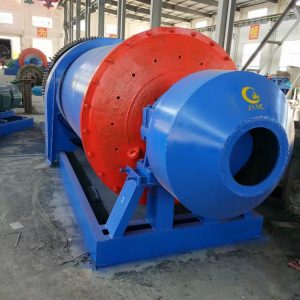
The structure of the sub-type ball mills of various specifications is basically the same. The cylinder of the ball mill is rolled and welded with a steel plate with a thickness of about 18 to 36 mm. The two ends of the ball mill are welded with cast steel flanges, and the cylinder is equipped with lining plates. It is made of manganese steel, chromium steel, wear-resistant cast iron or rubber, among which high manganese steel is widely used, and the use of rubber is still in the trial production stage. The thickness of the liner is about 50-130 mm, and there is a gap of 10-14 mm between the shell and the shell. Plywood, asbestos pads, or plastic poles or rubber are used to spread the impact of the steel ball on the simplified.
(2) Overflow type ball mill
overflow type ball mill because its discharging is by the oar propeller itself higher than the lower edge of the hollow shaft and overflow by itself, no need to install a heavy grid plate. In addition, in order to prevent the small balls and coarse-grained ore lump from being discharged together with the pulp in the ball mill, the inner surface of the hollow journal bushing is inlaid with reverse spiral blades.
(3) Rod mill
At present, there are only two types of rod mills in use in concentrators: overflow type and open type. The former is more commonly used, while the latter is no longer manufactured. The structure of the rod mill is roughly the same as that of the overflow type ball mill. The grinding medium used is a long round rod.
The rod mill is available in two forms, dry and wet, and users can choose according to their actual conditions. In over 20 years of grinding equipment design and manufacturing, our jxsc has adopts advanced controllable feeding and discharging technology, combined with the actual grinding material, should be equipped with a suitable grinding body, and the traditional surface contact is changed to line contact, so that the discharge particle size is more uniform and the output is higher. Widely used in refractory, chemical, metallurgical, glass and other industries that require relatively high uniformity of the finished product after grinding. In recent years, it has also been used in the sand making industry for construction sand.
(4) Centrifugal mill
Centrifugal mill is a new type of high-efficiency ultra-fine equipment, which is divided into two types: vertical and horizontal. According to the number of tubes, the former can be divided into single tube and three tube (planetary) centrifugal mills.
(5) Vibration mill
Vibration mill works at high frequency, and high frequency vibration is easy to cause cracks in the material, and can produce quite high stress concentration in the cracks, so it can effectively perform ultra-fine grinding. However, the spring of this kind of machinery is prone to fatigue and damage, the liner is also consumed, the amplitude used is small, the feed should not be too thick, and it is required to be uniformly added, so it is usually suitable for grinding materials of 1 to 2 mm to 85~ 5 microns (dry grinding) or 5 to 0.1 microns (wet grinding).
(6) Jet mill
Jet mill is a new type of dry grinding equipment that integrates fine grinding, classification, and drying of materials. Mainly used in the chemical and building materials industry, but recently there is a trend for ore grinding. The working condition of the jet mill is: use high-temperature compressed air, or superheated steam, or other preheated gas as the medium. Compared with ball mills and gravel mills, the separation index of jet mill products containing iron-containing quartzite after magnetic separation shows that the concentrate grade is about 2 to 3% higher, and the iron recovery rate is about 2 to 15% higher.
(7) Spiral classifier
Spiral classifier is the equipment matched with the wet ball mill and the ball mill to complete the grinding and classification together. Its specifications are expressed by diameter, and can be divided into single spiral classifier and double spiral classifier according to the number of spirals. According to the level of the liquid level, it can be divided into high weir type, immersion type and low weir type.
The classifiers produced by jxsc mining machinery include high weir type single screw and double screw, submerged single screw and double screw classifiers. This classifier is widely used in concentrators and ball mills to form a closed-circuit process to split ore sand, or used in gravity concentrators to classify ore and fine mud, and to classify ore slurry in the metal beneficiation process, and to wash ore Desliming, dewatering and other operations in operation. The classifier has the characteristics of simple structure, reliable work and convenient operation.
(8) Hydrocyclone
The upper part of the hydrocyclone is cylindrical, and the lower part is cone-shaped. An overflow pipe is inserted in the center of the cylinder, and a slurry inlet pipe tangent to the upper outside. Hydrocyclones have been used in mineral processing plants in my country for many years, and are mainly used for fine-grained classification, slurry concentration, desliming and dewatering.

